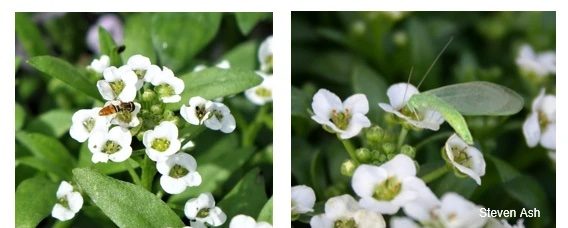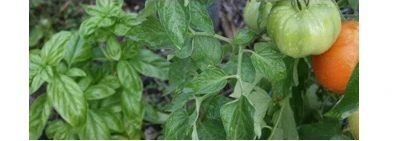
Fact Sheets And Publications
The "New" Companion Planting: Adding Diversity to the Garden
Do tomatoes love basil but hate brussels sprouts? Traditional companion planting, which involves planting different types of plants together or in close proximity, makes many such statements, often based on little more than folklore. In recent decades, however, scientists have found that in fact there are definite benefits to adding diversity to your garden, primarily because certain plants attract and support beneficial insects that either help control pests or help pollinate your crops.
Why add diversity?
- Resources from flowers, i.e. nectar and pollen:
- Attract and support predators and parasitoids (natural enemies) for pest control. Some tiny parasitoids require nectar or another source of sugar, and abundant nectar improves their survival and increases reproduction. Syrphid or hover flies feed on nectar and pollen, and lay hundreds of eggs near soft bodied insects such as aphids. The eggs hatch into larvae that are voracious feeders on those small pests. Lacewings and ladybird beetles are also attracted to flowers and can effectively control aphids.
- Attract and support pollinators, providing nectar and pollen that bees and butterflies need.

- Some flowers support alternate prey for natural enemies. For example, marigolds often support numerous tiny pest insects called thrips, which in turn are fed on by tiny voracious predatory bugs, Orius species, also known as minute pirate bugs. The Orius may also patrol nearby crop plants, reducing populations of soft-bodied pests. Marigolds are also well-known for their ability to control nematodes due to the toxic chemicals exuded by their roots; however, this works better when marigolds are planted as a cover crop, with their residues tilled into the soil before the crop is planted.

- The presence of different plant species grown together can disrupt the ability of pests to find their host plants. Plant-feeding insects, especially those that only feed on one or a few types of plants, find their host plants by sight and smell, and these cues can be disrupted by surrounding plants, especially aromatic or bushy plants.
- Adding ground-level complexity, for example strips of grass, weeds, or cover crops, can increase populations of ground-dwelling generalist predators, such as ground beetles and spiders, which can feed on plant-feeding insects, especially those that spend a part of their lives in the soil. Grassy “beetle banks” also provide sheltered overwintering habitat for insect predators.
- Caution: although there are many studies showing that diverse plantings increase populations of natural enemies, this does not always translate into fewer pests on the desired crop plant, since the predators and parasitoids may not disperse to where they are needed. You will still need to check your plants frequently for unwanted pests, and control them in some other way if the good bugs are not effective enough!
- In addition, the added plants will compete with the crop for light, water, and nutrients, and therefore crop yield may be reduced compared to a monoculture of the crop. Select companion plants that are not overly competitive with the main crop.
- Other examples where diverse plantings make sense. Plants with different characteristics can be used to support soil nutrition and better yield in a small space. For example, legumes, such as alfalfa, clover, peas, and beans, fix nitrogen and can be planted in rotation with non-legumes; deep-rooted plants can be grown with shallow-rooted plants; and sun-loving plants can provide shade for shade-loving plants and also help to reduce weeds. A classic example of this type of companion planting is the so-called “three sisters” planted together by Native Americans. Corn, pole beans, and squash were planted together, with corn providing support for the beans and the large squash leaves suppressing weeds.
How to add diversity?
Combine crop plants with other annual or perennial plants in the vegetable bed.
- Herbs are desirable crops themselves, and often produce small flowers with exposed nectaries that attract and support predators and parasitoids. They also tend to be aromatic. Herbs that have been shown to attract natural enemies or repel herbivores in at least some studies include basil, coriander, rosemary, lavender, parsley, borage, dill and chives.

- Annual flowers can be planted in the beds around vegetables. In the Master Gardener Vegetable and Fruit Demonstration Garden (VFDG) at the New Castle County Cooperative Extension Office, sweet alyssum has been planted within vegetable beds for several years to attract and support beneficial insects. Alyssum is inexpensive, easy to grow, low growing and compact (so it doesn’t compete with the vegetables), has a long growing season, and doesn’t leave significant biomass at the end of the season. It can be grown from seed, but at the VFDG plants are typically purchased, for convenience and quick establishment. Numerous syrphid flies (mentioned above) can be seen swarming about the flowers in the spring. Other popular choices are marigolds and nasturtiums. Some popular annual plants such as pansies, however, have been selected primarily for large colorful flowers and may not produce the nectar and pollen needed by beneficial insects.

- Plant flowering native perennials in a bed near the garden. The VFDG also has a native perennial bed, consisting of various species that bloom at different times and are known to attract and support beneficial insects (see RESOURCES for plants to consider).
- Plant flowering shrubs and trees in a nearby hedgerow. If you have room for trees and shrubs, this is a great way to add additional flower resources, in addition to berries and habitat for birds. Trees are often the first source of flowers in the spring (see RESOURCES).
RESOURCES
- Michigan State has research-based lists of native perennial herbaceous plants of Michigan that are attractive to both pollinators and natural enemies. Most of these are also native to our region: http://www.canr.msu.edu/nativeplants/plant_facts/
- Michigan State also produced a multistate bulletin on protecting and enhancing pollinators in urban landscapes
- The University of Kentucky has developed a research-based list of flowering woody landscape plants (trees and shrubs) that are attractive to bees: https://entomology.ca.uky.edu/files/bee_friendly_shrubs_and_trees_handout.pdf
- The North American Pollinator Protection Campaign (NAPPC), and its parent organization, the Pollinator Partnership, offers eco-regional planting guides for pollinator-friendly landscapes. These include trees, shrubs, and perennials that attract and support pollinators as well as host plants for butterflies: http://pollinator.org/guides
- The Delaware Department of Agriculture has published a guide to planting for native bees in Delaware (both coastal plain and piedmont), including a list of 39 herbaceous and woody species with bloom time and types of bees that are attracted (Sarver, M.J. 2009. Delaware Native Plants for Native Bees). A guide to creating relatively large-scale meadows friendly to pollinators is also available: http://matthewsarver.com/downloads/Meadows_and_Buffers_for_Bees.pdf
- The Delaware Nature Society has a list of resources relevant to planting for a certified wildlife habitat and related subjects: https://www.delawarenaturesociety.org/what-we-do/protecting-habitats-wildlife/garden-for-wildlife/?CWH=6
- The Xerces Society for Invertebrate Conservation includes both herbaceous and woody plants in this list of pollinator-friendly plants for the Mid-Atlantic Region: https://xerces.org/pollinator-conservation/plant-lists/pollinator-plants-mid-atlantic-region/
- The National Wildlife Federation has a section on native plants of value to wildlife, including a Native Plant Finder to assist in finding plants that support caterpillars: https://www.nwf.org/Garden-For-Wildlife/About/Native-Plants.aspx
- The Lady Bird Johnson Wildflower Center Native Plant Database is searchable for a variety of characteristics, including value to native insects: wildflower.org/plants/
- As part of his website “Illinois Wildflowers,” Dr. John Hilty lists flowers that have been observed to be attractive to insects and birds, based on a variety of scientific publications: http://www.illinoiswildflowers.info/flower_insects/index.htm
UD Cooperative Extension
This institution is an equal opportunity provider.
In accordance with Federal law and U.S. Department of Agriculture policy, Cooperative Extension is prohibited from discriminating on the basis of race, color, national origin, sex, age, or disability.
